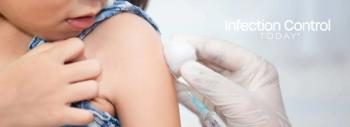
Lessons in Linen
Lessons in Linen
Following Aseptic Technique in the Laundry Department
By Kelly M. Pyrek
When it comes to protectinghospital personnel from the transmission of infectious diseases, thepatient-care delivery worker is often the person thought of first; however,infection control practitioners must be aware that the handling of healthcarefacility laundry and linen poses risks to another population of hospital worker.Laundry personnel are responsible for processing hundreds of thousands of poundsof contaminated reusable linens annually and can be at risk for injury ifprecautions are not taken.
Infection control consultant Raymond Otero, PhD, formerly director ofacademic affairs for the National Association of Institutional Linen Management(NAILM)1 says infection control manuals should be written to allayfears regarding the processing of contaminated linen, and adds that if commonsense procedures -- dictated by Standard Precautions (SP) -- are followed, thechance of disease transmission is "almost nonexistent." Heacknowledges there have been several documented cases of contaminated linensserving as the cause of infections such as scabies, salmonella and smallpoxamong laundry handlers, and these can be attributed to breaks in aseptictechnique.
While there is ongoing debate as to how big a role linens play in thetransmission of disease, this fomite has been indicted in a number of recentstudies.
In a study by Borg and Portelli2 published in 1999 titled,"Hospital laundry workers -- an at-risk group for hepatitis A?"researchers related the experiences of 22 laundry personnel at St. Luke'sHospital in Malta, who were tested for seropositivity to hepatitis A. They werematched with 37 nursing aides working in pediatric and infectious disease wards,who were used as controls. IgG antibodies were found in 54.5 percent of laundryworkers and 13.5 percent of nursing aides [odds ratio (OR) = 7.68; 95 percent;confidence interval (CI) = 1.87-33.83]. Furthermore, laundry personnelconsistently handling dirty linen prior to washing showed an OR of 16.50 (CI =1.19-825.57) as compared with colleagues handling only clean items. Theresearchers say these results suggest that the increased exposure of hospitallaundry workers to potentially infected linen can constitute a risk ofoccupational hepatitis A for this group of employees.
In another published study, researchers Standaert, Hutcheson and Schaffner3examined the nosocomial transmission of Salmonella gastroenteritis to laundryworkers in a nursing home in a rural Tennessee county. Residents and staff ofthe nursing home were interviewed and cultures of stool samples examined forenteric pathogens. Stool cultures from 32 residents and eight employees werepositive for Salmonella hadar. Infection among the residents was foodborne, butinfection among employees likely represented secondary transmission, as none ofthe employees ate food prepared in the kitchen and their onset of symptomsoccurred seven to 10 days after that of ill residents. Three laundry personnelwho had no contact with residents were infected. Most of the ill residents (81percent) were incontinent, which led to an increase in both the degree of fecalsoiling and the amount of soiled linen received by the laundry during theoutbreak. Laundry personnel regularly ate in the laundry room, did not wearprotective clothing and did not wear gloves consistently while handling soiledlaundry. The researchers concluded that linen soiled with feces was the sourceof nosocomial S.Hadar infection in laundry workers and underscore the importanceof using appropriate precautions when handling linen.
The Centers for Disease Control and Prevention (CDC)'s Guidelines for Laundryin Healthcare Facilities say that, "Although soiled linen has beenidentified as a source of large numbers of pathogenic microorganisms, the riskof actual disease transmission appears negligible. Rather than rigid rules andregulation, hygienic and common-sense storage and processing of clean and soiledlinen are recommended."4-5
Contaminated laundry, as defined by the Bloodborne Pathogen Standard issuedby the Occupational Safety and Health Administration (OSHA), is considered to be"laundry which has been soiled with blood or other potentially infectiousmaterial or may contain sharps."
OSHA says healthcare facility laundry poses exposure to blood or otherpotentially infectious materials through contaminated linen that was improperlylabeled or handled. It suggests the following solutions to healthcare workersand laundry personnel to avoid occupational exposure:
- Handle contaminated laundry as little as possible with minimal agitation.
- Bag contaminated laundry at the location of use. Do not sort or rinse laundry at the location where it was used.
- Place wet contaminated laundry in leak-proof, and color-coded or labeled containers, at the location where it was used.
- Whenever contaminated laundry is wet and presents a reasonable likelihood of soak-through or of leakage from the bag or container, the laundry shall be placed and transported in bags or containers which prevent soak-through and/or leakage of fluids to the exterior.
- Contaminated laundry must be placed and transported in bags or containers labeled with the biohazard symbol or put in red bags.
- In a facility that utilizes universal precautions in the handling of all soiled laundry alternative labeling or color-coding is sufficient if it permits all employees to recognize the containers as requiring compliance with standard precautions.
- Use red bags or bags marked with the biohazard symbol, if the facility where items are laundered does not use SP for all laundry.
- Contaminated laundry bags should not be held close to the body or squeezed when transporting to avoid punctures from improperly discarded syringes.
- Normal laundry cycles should be used according to the washer and detergent manufacturer's recommendations.
Otero says that all healthcare workers and laundry personnel must follow SPwhen handling contaminated linen, including donning personal protectiveequipment (PPE) including gloves and gowns that provide adequate barrierproperties. Handwashing facilities, including a hygienic sink, soap dispensersand paper towels, must be provided in the soiled-linen processing facility.
The CDC offers the following control measures for proper laundry handling:
- Soiled linen can be transported in the hospital by cart or chute. Bagging linen is indicated if chutes are used, since improperly designed chutes can be a means of spreading microorganisms throughout the hospital.6
- Soiled linen may or may not be sorted in the laundry before being loaded into washer/extractor units. Sorting before washing protects both machinery and linen from the effects of objects in the linen and reduces the potential for recontamination of clean linen that sorting after washing requires. Sorting after washing minimizes the direct exposure of laundry personnel to infective material in the soiled linen and reduces airborne microbial contamination in the laundry.7 Protective apparel and appropriate ventilation can minimize these exposures.
The microbicidal action of the normal laundering process is affected byseveral physical and chemical factors.8-10 Although dilution is not amicrobicidal mechanism, it is responsible for the removal of significantquantities of microorganisms. Soaps or detergents loosen soil and also have somemicrobicidal properties. Hot water provides an effective means of destroyingmicroorganisms, and a temperature of at least 71 degrees C (160 F) for a minimumof 25 minutes is commonly recommended for hot-water washing. Chlorine bleachprovides an extra margin of safety. A total available chlorine residual of50-150ppm is usually achieved during the bleach cycle. The last action performedduring the washing process is the addition of a mild acid to neutralize anyalkalinity in the water supply, soap, or detergent. The rapid shift in Ph fromapproximately 12 to 5 also may tend to inactivate some microorganisms.
Recent studies have shown that a satisfactory reduction of microbialcontamination can be achieved at lower water temperatures of 22-50 degrees Cwhen the cycling of the washer, the wash formula, and the amount of chlorinebleach are carefully monitored and controlled. Instead of the microbicidalaction of hot water, low-temperature laundry cycles rely heavily on the presenceof bleach to reduce levels of microbial contamination.
Regardless of whether hot or cold water is used for washing, the temperaturesreached in drying and especially during ironing provide additional significantmicrobicidal action.
Otero says airborne transmission notwithstanding, the real threat posed bycontaminated linen is avoiding injuries from sharps like needles, razor bladesand surgical instruments being swept up in patient-room or surgical linens.Otero says that proper linen handling can help eliminate these kinds ofinjuries, and that healthcare workers must be inserviced on how to look forsharps buried in linen and how to remove and contain them.
A safety and health program that includes procedures for appropriate disposaland handling of sharps and follows required practices is outlined in theBloodborne Pathogens Standard.
OSHA makes the following recommendations regarding sharps handling:
- Contaminated needles and sharps shall not be bent, recapped or removed. No shearing or breaking is permitted.
- Follow sharps containerization guidelines:
1. Immediately or as soon as feasible, contaminated sharps need to bediscarded in appropriate containers.
2. Needle containers need to be available, and in close proximity to areaswhere needles may be found, including laundries.
3. Appropriate containers must be closable, puncture-resistant and leak-proofon sides and bottom; accessible, maintained upright and not allowed to overfill;labeled with the biohazard symbol; labeled in fluorescent orange or orange-red,with lettering and symbols in a contrasting color; red bags or containers may besubstituted for labels.
One more set of related guidelines offered to healthcare laundry services canbe found within the Association for the Advancement of Medical Instrumentation (AAMI)'sProcessing of Reusable Surgical Textiles for Use in Healthcare Facilities (ANSI/AAMIST65), a document that discusses clean, non-sterile, reusable surgical textilesand sterile, reusable surgical textile packs. ST 65 is intended to helpmaterials managers, laundry managers, central service managers and otherhealthcare professionals implement effective quality-assurance systems for theprocessing of reusable surgical textiles. The guidelines include instruction forproper on-site or off-site handling, processing and preparation of reusabletextiles in healthcare facilities as well as design criteria for work areas,staff qualifications and training, and procedures for receiving and handlingsoiled textiles, transporting both clean and soiled textiles, and installing,caring for and maintaining laundry equipment. ST 65 also explains reprocessingconsiderations, quality control practices and regulatory considerationsincluding regulations from the Environmental Protection Agency (EPA) and OSHA.For more information, visit
Newsletter
Stay prepared and protected with Infection Control Today's newsletter, delivering essential updates, best practices, and expert insights for infection preventionists.






